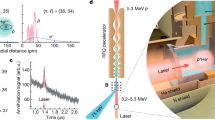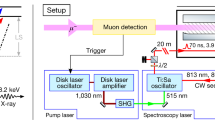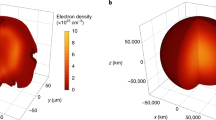Abstract
THE series of hydrogen- and helium-like spectra, which was previously traced 1 to Be IV, has now been completed with B IV, B V, and C V, and the limit of optical spectra brought down to 40.28 A.
This is a preview of subscription content, access via your institution
Access options
Subscribe to this journal
Receive 51 print issues and online access
$199.00 per year
only $3.90 per issue
Buy this article
- Purchase on Springer Link
- Instant access to full article PDF
Prices may be subject to local taxes which are calculated during checkout
Similar content being viewed by others
References
B. Edlén and A. Ericson, NATURE, 125, 233; 1930; and Zeit. f. Phys., 59, 656; 1930.
E. Ekefors, Physik. Zeitschr., 31, 737; 1930.
W. G. Penney, Phil. Mag., 9, 661; 1930.
E. A. Hylleraas, Naturwiss., 17, 982; 1929.
Author information
Authors and Affiliations
Rights and permissions
About this article
Cite this article
EDLÉN, B. Vacuum Spark Spectra to 40 A.: the Spectra of Be III, Be IV, B IV, B V, and C V. Nature 127, 405–406 (1931). https://doi.org/10.1038/127405b0
Issue Date:
DOI: https://doi.org/10.1038/127405b0
This article is cited by
-
Vakuumfunkspektren von Kalium und Calcium im Gebiete 100 bis 1100 �
Zeitschrift f�r Physik (1931)
Comments
By submitting a comment you agree to abide by our Terms and Community Guidelines. If you find something abusive or that does not comply with our terms or guidelines please flag it as inappropriate.



